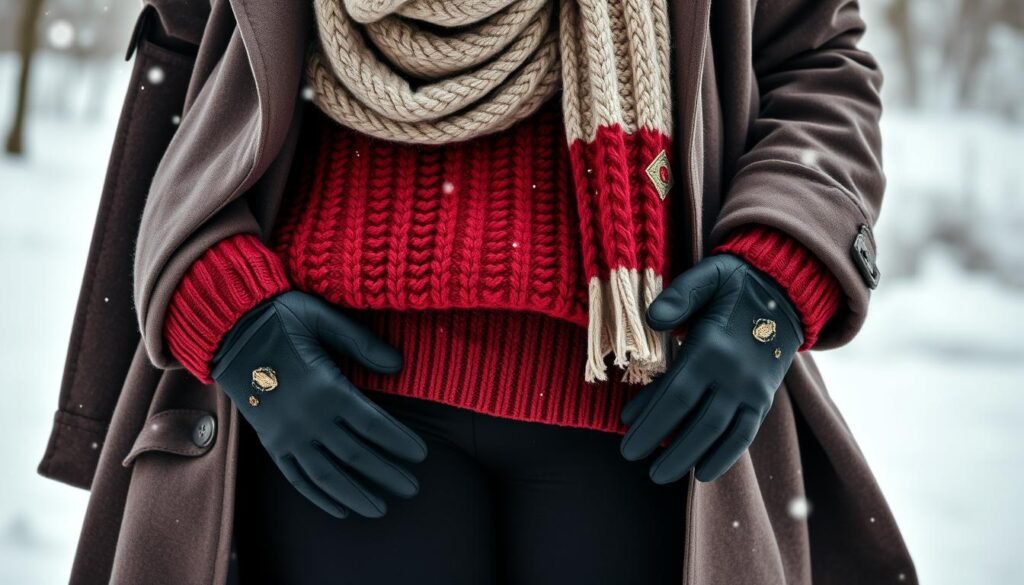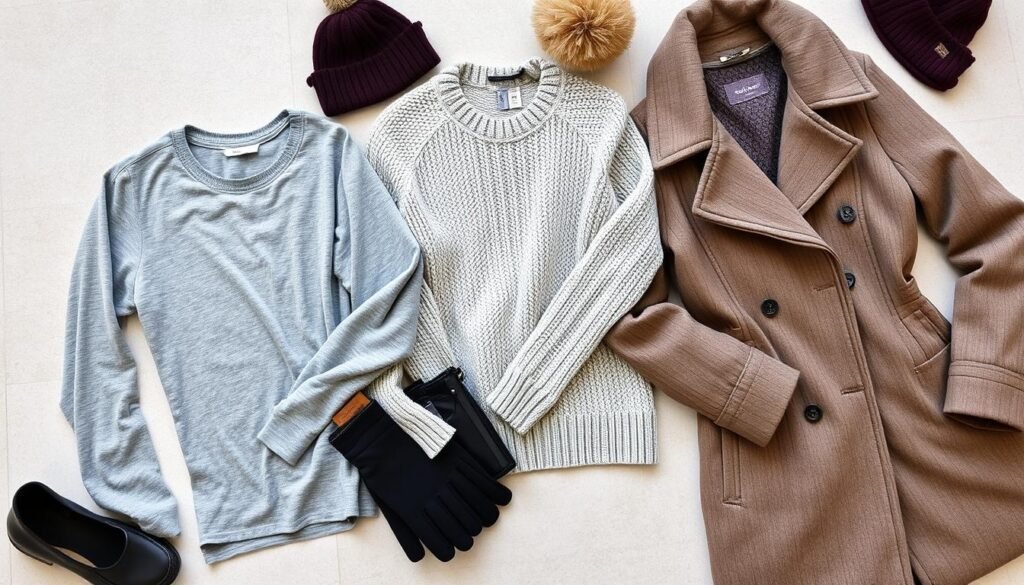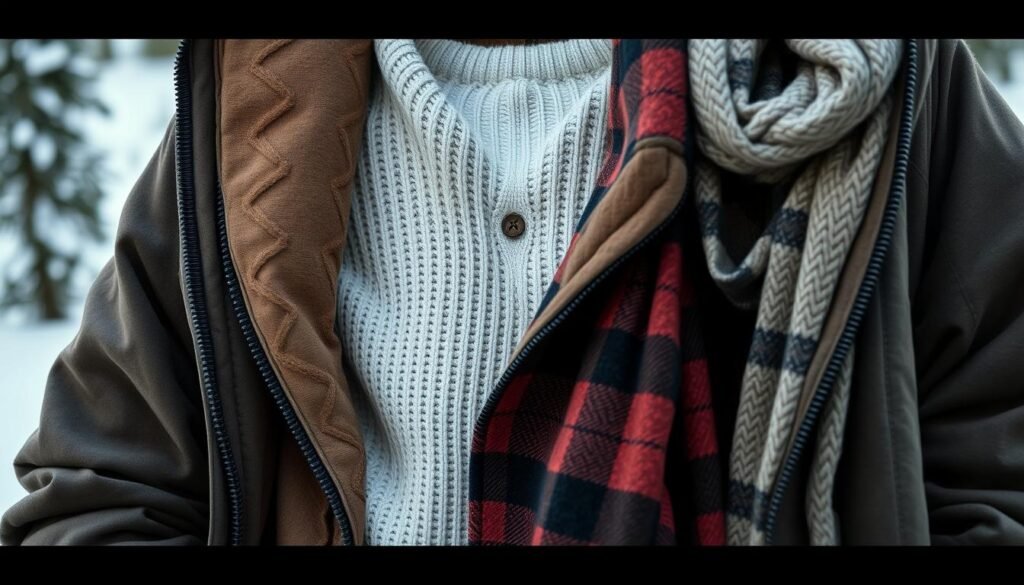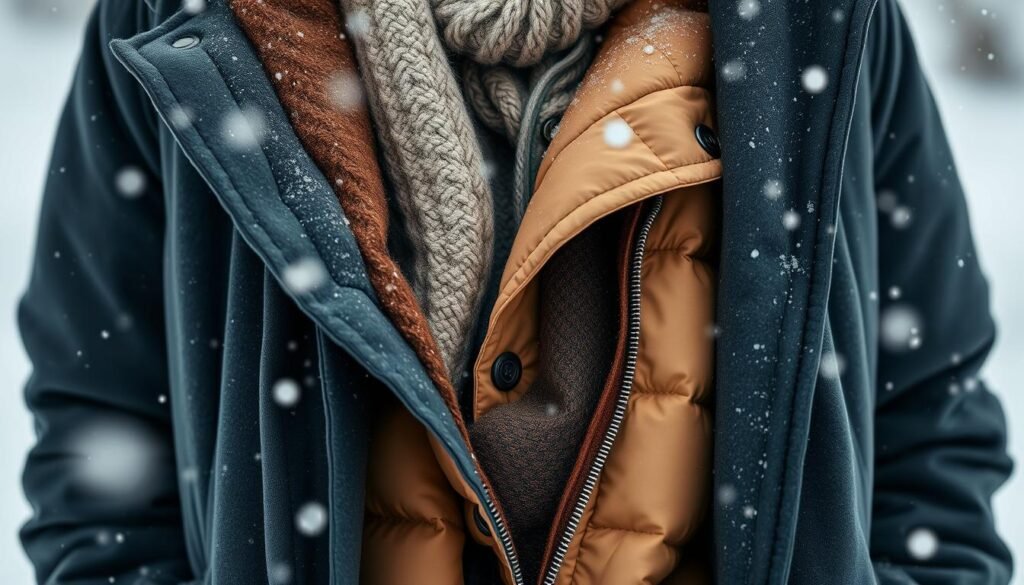
Did you know a well-layered outfit can keep you 50% warmer than a single thick coat? Layering is key to staying warm and comfy in winter. By learning the science and techniques of layering, you can beat the cold and enjoy winter in style.
Key Takeaways
- Layering is a highly effective strategy for trapping heat and staying warm in cold weather.
- The three-layer system (baselayer, midlayer, outer layer) is a tried-and-tested approach for optimal insulation and breathability.
- Choosing the right fabrics, such as merino wool, synthetic materials, and down, is crucial for effective layering.
- Balancing warmth and breathability is essential to prevent overheating or feeling cold and clammy.
- Incorporating smart additions like hats, gloves, and scarves can further enhance your winter layering game.
The Science Behind Layering
Layering is more than just wearing many clothes. It’s about how your body keeps warm and how clothes work together. It’s about trapping warm air and letting out moisture.
Understanding the Basics of Layering
Good layering traps warm air and lets moisture out. Each layer has its job to keep you warm. It’s all about conduction, convection, and radiation to keep you warm in cold.
Importance of Layering in Cold Weather
Layering is key in cold weather. It helps keep your body’s core warm. When it’s cold, your body loses heat, but layers help slow this down.
Knowing how layering works is important. It helps you stay warm and comfortable in cold weather. It’s all about the right materials and how they work together.

“Layering is essential for maintaining body temperature and providing insulation in cold weather. By creating air pockets between the layers, you can effectively trap heat and slow the transfer of heat from your body to the environment.”
Choosing the Right Materials for Layering
Staying warm in cold weather depends on the materials you choose for layering. Mixing natural and synthetic fabrics is key. This mix offers the best insulation, breathability, and moisture-wicking.
Natural fibers like wool are great for keeping warm, even when wet. They trap air well, keeping you warm without being too heavy. Synthetic materials, such as polyester and nylon, are durable, dry quickly, and wick away moisture from your skin.
Down and fleece are top picks for insulation. Down, from goose or duck feathers, is very warm for its weight. It’s perfect for extreme cold. Fleece is light, breathable, and insulates well, making it great for many winter activities.
Choosing the right materials depends on your activity, the weather, and what you like. A mix of natural and synthetic fibers keeps you warm, dry, and comfy, no matter the weather.
“The key to successful layering is choosing the right materials for each layer to optimize warmth, breathability, and moisture management.”
Knowing the benefits of different fabrics helps you build a warm and versatile winter wardrobe. This keeps you comfortable and safe in the coldest weather.
The Three-Layer System Explained
The three-layer system is a proven way to stay warm in cold weather. It involves wearing different layers to manage body temperature, keep dry, and protect from the elements. Let’s explore the role and benefits of each layer in this system.
The Baselayer
The baselayer is the closest to your skin. It’s key for managing moisture. Polyester and merino wool are top picks because they draw sweat away and keep you dry. Its tight fit helps move moisture efficiently, keeping you comfortable.
The Midlayer
The midlayer adds warmth and traps heat. Fleece and down are great for this because they’re warm without being too heavy. It should fit loosely to allow air to circulate, balancing warmth and breathability.
The Outer Layer
The outer layer, or shell, protects you from wind, rain, and snow. Gore-Tex is a top choice because it’s waterproof and lets sweat out. It should be roomy to fit over other layers without limiting movement.
Together, these three layers make a flexible system for cold weather. Learning to layer is key to staying warm, dry, and comfortable outdoors.

| Layer | Purpose | Recommended Materials |
|---|---|---|
| Baselayer | Moisture management and temperature regulation | Polyester, merino wool |
| Midlayer | Insulation and heat retention | Fleece, down |
| Outer Layer | Protection against wind, rain, and snow | Gore-Tex, waterproof and breathable fabrics |
How to Layer Under a Winter Coat
Learning to layer under a winter coat is key to staying warm. By mixing different fabrics and clothes, you can keep your body temperature right. This also helps to remove moisture and protect you from the weather.
Finding the right mix of insulation and breathability is crucial. Start with a baselayer that wicks away moisture, like synthetic fibers or merino wool. Then, add a midlayer like fleece or down to keep you warm. Finish with a outer layer that’s waterproof and keeps out wind and snow.
- Avoid cotton: It absorbs moisture and can leave you vulnerable to hypothermia.
- Opt for fabrics like polyester or merino wool for your baselayer to wick away sweat.
- Layer your midlayer with a lightweight, breathable fleece or a warm down jacket.
- Choose an outer layer made from waterproof and breathable materials like Gore-Tex to keep you dry and comfortable.
It’s not just the outer layer that keeps you warm. How you layer, the fabrics you choose, and the fit are all important. By learning to layer well, you can enjoy the outdoors and stay warm in a winter coat all season.
| Layer | Fabric | Purpose |
|---|---|---|
| Baselayer | Synthetic or Merino Wool | Moisture-wicking, Insulation |
| Midlayer | Fleece, Down | Insulation, Warmth |
| Outer Layer | Waterproof, Breathable | Weather Protection |

“On cold, windy days, hypothermia can set in within less than five minutes once you stop moving.” – Eric Larsen, Polar Explorer
Balancing Warmth and Breathability
Finding the right mix of warmth and breathability in cold weather is key. You need to pick fabrics that manage moisture well and keep your body temperature steady. This is crucial for staying comfortable in the cold.
Tips for Effective Layering
Here are some tips to balance warmth and breathability:
- Start with a good base layer: Go for moisture-wicking fabrics like polyester or merino wool. They keep your skin dry and comfy.
- Use a versatile midlayer: Fleece or down-filled clothes offer great warmth and still let you breathe.
- Protect with an outer layer: Pick a jacket or coat that’s waterproof and windproof. It keeps the cold out.
- Make room for air: Leave a little space between layers. This helps trap warm air and keeps you cozy.
- Adjust as needed: Don’t be afraid to add or remove layers. This keeps you comfortable as the weather changes.
By using these tips, you can master the art of layering under a winter coat. You’ll stay warm, dry, and comfy, even in the coldest weather.

Enhancing Winter Layering: Smart Additions
The classic three-layer system is great for staying warm in winter. But, adding a second mid-layer, like a fleece jacket, can boost your warmth without bulk. A puffy down jacket as your outer layer adds warmth without weighing you down.
Accessories like hats, gloves, and thick socks are crucial for keeping your extremities warm. Adding these to your winter layering helps keep your body temperature stable. This prevents heat loss from your head, hands, and feet.
- Invest in a high-quality down jacket or vest for superior insulation.
- Incorporate a second mid-layer, such as a lightweight fleece or sweater, for added warmth.
- Protect your extremities with a warm hat, gloves, and thick, moisture-wicking socks.
- Avoid cotton, which retains moisture and can lead to chilling, in favor of synthetic or merino wool fabrics.
| Accessory | Purpose | Recommended Material |
|---|---|---|
| Hat | Retain body heat, protect from wind and cold | Wool, fleece, or synthetic |
| Gloves | Prevent heat loss through the hands | Waterproof, insulated gloves or mittens |
| Socks | Keep feet warm and dry | Wool or synthetic, moisture-wicking |
By adding these smart layers to your winter outfit, you can stay warm, comfortable, and safe outside. This ensures a fun and safe time outdoors.

“The key to staying warm in the winter is all about layering. Adding extra layers and accessories can make a significant difference in your overall comfort and performance.”
The Overlooked Dangers of Winter: Excess Heat
Winter layering is all about staying warm. But, overheating is a big risk in cold weather. If you don’t manage moisture and control your body heat, your clothes can get wet. This makes them lose their insulating power and puts you at risk of freezing.
Many people don’t realize the dangers of overheating in winter. It’s important to manage moisture and shed layers when you get too warm. Keeping your body temperature in check helps prevent overheating and the dampness that comes with it.
The Importance of Moisture Management
When you’re active in the cold, your body heats up. If you don’t manage this heat, you’ll sweat a lot. Moisture management in your winter clothes is key to avoiding dampness. This dampness can quickly take away your natural insulation.
- Choose base layers and mid-layers made of moisture-wicking fabrics like synthetic or merino wool to help transport sweat away from your skin.
- Ensure your outer layer is breathable and has features like pit zips or vents to allow excess heat and moisture to escape.
- Be mindful of your activity level and shed layers as needed to prevent overheating and the subsequent dampness that can compromise your insulation.
Regulating Body Temperature
Keeping your body temperature right is key in cold weather. Overheating can make you sweat a lot. If you’re not careful, this sweat can quickly turn to a dangerous chill.
| Scenario | Temperature | Risk |
|---|---|---|
| Wind chill factor | -36°C (-33°F) | Skin freezing in under 8 minutes |
| Hypothermia | N/A | Caused by excessive sweating and loss of body heat |
| Frostbite | N/A | Increased risk with exposed skin in extreme cold |
To stay safe and comfortable in winter, find the right balance between keeping warm and staying dry. Shed layers as needed to avoid overheating and its dangers. With good moisture management and body temperature regulation, you can enjoy winter without risking your health.
Embracing the Winter Wonderland
When it gets cold and snow falls, the outdoors calls for fun. Enjoying winter activities and hiking in the snow can be rewarding. It’s a chance to explore and see nature’s beauty.
Staying warm outside is key to enjoying winter. By dressing right, you can stay cozy and stylish. This lets you enjoy the fresh air without getting cold.
Choosing the right clothes is important. Look for layers that work together. This way, you can adjust to the weather and stay comfortable.
Let winter’s beauty inspire you. Go for a hike, try snowshoeing, or just walk in the snow. Connecting with nature in winter is special.
With the right attitude and gear, winter can be exciting and peaceful. Embrace the season’s wonders. Make winter hiking and adventures a yearly highlight.
Conclusion
Learning how to layer under a winter coat is crucial for staying warm and comfortable. It’s about understanding the science of layering, picking the right materials, and using the three-layer system. This way, you can enjoy the outdoors, even when it’s very cold.
Choosing between merino wool and fleece is important. The goal is to find a balance between keeping warm and staying breathable. Adjust your clothes as the weather and your activity change.
When you go outside, watch out for overheating. Keep your body temperature just right. With the right layering, you’ll be ready for any winter adventure.
